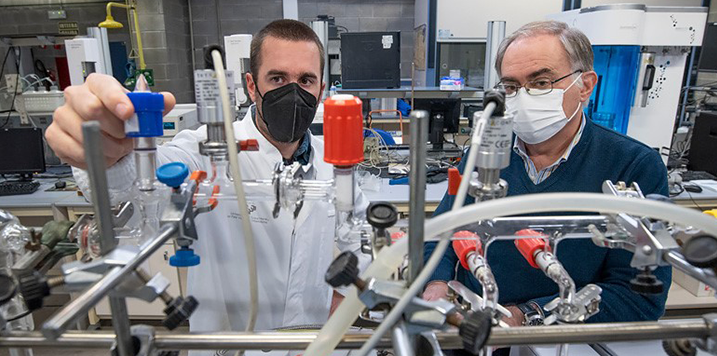Redirecting to

 31 de January de 2022
31 de January de 2022The CATART project, headed by the SUPREN (SUstainable PRocess ENgineering) research team of the Chemical Engineering and Environmental Department of the Bilbao School of Engineering (UPV/EHU) will combine their knowledge of photonics, materials science, catalysis, chemical engineering and artificial intelligence to develop a revolutionary technology to produce chemical products.
The goal of the European CATART project, which has received a grant of 3.2 million euros from the European Union’s HORIZON-EIC-2021-PATHFINDEROPEN-01 program, is to design a technology that combines the fields of materials science, artificial intelligence and chemical reactions to produce precursors of biofuels from renewable molecules, such as water and carbon dioxide.
To be more specific, “the project intends to develop a technology to collect solar light as a renewable energy source and use it to convert water or carbon dioxide molecules and produce hydrogen or carbon monoxide, respectively. Both products have a variety of uses in the chemical industry and the hydrogen can also be used as a green fuel”, explained Iker Aguirrezabal Telleria, head of the project and member of the SUPREN research team under Pedro Luis Arias. Therefore, “the goal is to design a technology or versatile prototype that can be operated by solar light both here and at other points on the planet and can, at the same time, adapt to the weather conditions at each location and learn to produce large amounts of hydrogen and carbon monoxide. The combination of knowledge about photonics, materials science, catalysis, chemical engineering and artificial intelligence (via machine learning) will pave the way to develop an independent technology capable of maximising productivity”, added Mr. Aguirrezabal.
The researcher also added the following: “the novelty of this technology lies in the design of a series of materials capable of carrying out a chemical reaction and then separating the product. Currently, there are no viable materials that produce these kinds of reactions and separations at the same time. Moreover, there is no technology or equipment that includes the three components: material design, light absorption and optimisation using artificial intelligence. Therefore, the technology intended to result from this project will revolutionise how certain chemical products are produced”.
The research team of the European CATART project is made up of eight partners from five European countries: five universities, a research centre, an SME and an industrial partner. The SUPREN- SUstainable PRocess ENgineering Group of the Chemical Engineering and Environmental Department of the Bilbao School of Engineering (UPV/EHU) is at the head of the project along with the University of Pavia (Italy), the University of Glasgow (United Kingdom), the University of Eindhoven (Holland) and the University of Amsterdam (Hollanda); the Max Planck Institute of Berlin (Germany); Chemify, the startup associated with the University of Glasgow that works on robotics and artificial intelligence and the English company Johnson Matthey, which centres mainly on the design and production of catalysts.
Subscribe to our newsletter. Just insert your e-mail and you will receive the latest news.
Redirecting to
